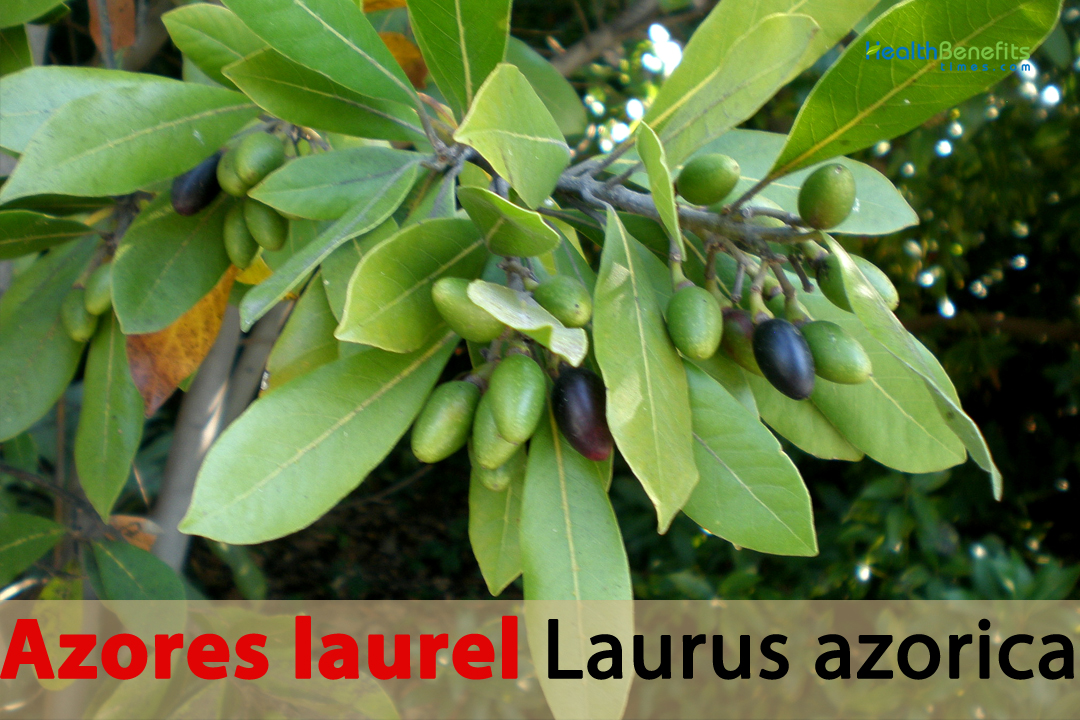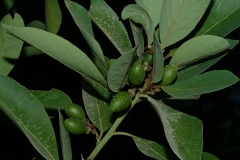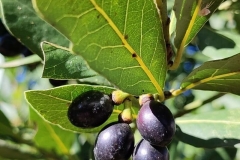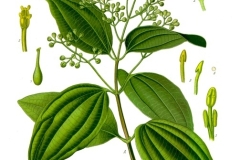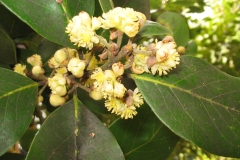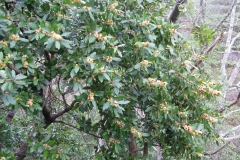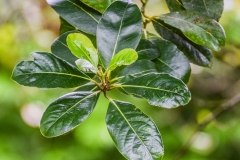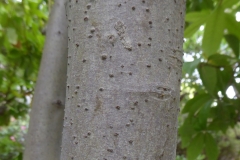| Azores laurel Quick Facts | |
|---|---|
| Name: | Azores laurel |
| Scientific Name: | Laurus azorica |
| Origin | Azores region, which is made up of nine volcanic islands |
| Colors | Initially green turning to dark purple to black |
| Shapes | Roughly spherical to slightly ovoid shaped drupe about 1 to 1.5 centimeters |
| Taste | Mild, slightly sweet, and aromatic flavor |
| Major nutrients | • Vitamin • Mineral • Antioxidants • Fiber • Essential Oils |
| Health benefits | Digestive Aid, Respiratory Health, Stress Reduction, Aid in Weight Management, Oral Health, Skin Health, Pain Relief, Cardiovascular Health, Weight Management, Liver Health, Anti-Aging, Urinary Tract Health, Aid in Menstrual Issues |
| Name | Azores laurel |
|---|---|
| Scientific Name | Laurus azorica |
| Native | Azores region, which is made up of nine volcanic islands about 1,400 km (870 miles) west of Portugal’s mainland |
| Common Names | Azores laurel, Azores bay laurel, Azores laurel tree, Azores bay tree, Azores laurel cherry, Azorean laurel, Macaronesian bay laurel, Azores bay cherry, Canary Islands bay tree, Azores evergreen laurel, Macaronesian laurel, Azores laurelwood, Azores baywood, Azores laurel bay, Azores mountain laurel, Portuguese laurel, Azores bayleaf, Azorean laurel bay, Atlantic laurel, Macaronesian laurel tree, Azores evergreen bay, Azores wild laurel, Portuguese bay cherry |
| Name in Other Languages | Arabic: Ghar Azawris (غار آزوريس) Asturian: lloréu de les azores Bulgarian: Azorski lavar (Азорски лавър) Chinese: Yàsù’ěr yuèguì shù (亚速尔月桂树), Yà sù ěr yuèguì (亚速尔月桂) Croatian: Azorski lovor Czech: Azorský bobkový strom, vavřín azorský Danish: Azorerlaurbær Dutch: Azoren laurier, Canarische laurier English: Azorean sweet bay, Azores laurel, Canary Island laurel, Fetid laurel, Macaronesian Laurel, Azorean laurel Esperanto: Acora laŭro Estonian: Azooria loorber Finnish: Azorienlaakeri, Azorienlaukka, Kanarianlaakeri French: Laurier des Açores Galician: Loureiro dos Azores German: Azorenlorbeer, Kanarischer Lorbeerbaum, Azoren-Lorbeerbaum Greek: Dáfni ton Azorón (Δάφνη των Αζορών), Lorída ton Azorón (Λωρίδα των Αζορών) Hebrew: Azor laurel (אזור לוראל) Hungarian: Azori babérfa Icelandic: Azores láréttur Italian: Alloro delle Azzorre, lauro delle Azzore Japanese: Azoresu gekkeiju (アゾレス月桂樹) Korean: Ajoeleseu wolgyesu (아조레스 월계수) Kurdish: Defneya Kurdistanê Latvian: Azoru lauru koks Lithuanian: Azorų šluota Norwegian: Azorerlaurbær, Azorene laurbær Polish: Wawrzyn azorski Portuguese: Louro das Açores, Loureiro-dos-Açores, Louro, Loureiro, Louro-da-terra, Louro-de-cheiro, louro-de-terra Romanian: Dafinul azorean Russian: Lavr azorski (Лавр азорский) Serbian: Azorski lorber Slovak: Azorský bobkový strom Spanish: Laurel de las Azores, laurel canario Swedish: Azorlager, Atlantlager Thai: Ton makok Azores (ต้นมะกอก Azores) Turkish: Azoradağları Defnesi Ukrainian: Azorska lavrova vitalnya (Азорська лаврова вітальня), Lavr azorsʹkyy (Лавр азорський) Upper Sorbian: Acorski ławrjenc Vietnamese: Cây Dương báp Azores |
| Plant Growth Habit | Small, slow-growing, dioecious, evergreen tree or large shrub |
| Growing Climates | Found in lava flows, margins of cultivated land, coastal scrubland, mountain scrubland and forested peat bogs |
| Soil | Well-draining soil with good moisture retention is essential |
| Plant Size | 10 to 15 meters (33 to 49 feet) and has a spread or canopy that ranges from 6 to 10 meters (20 to 33 feet) |
| Root | Roots are not very deep and are close to the soil’s surface, forming a thick network of small trunk-like roots |
| Stem | stem is woody, which means it is made up of lignified cells that give the plant its shape |
| Bark | bark on young trees is usually smooth and brownish-gray, but as the tree gets older, it often gets rougher and has more cracks in it |
| Leaf | Leaves similarly aromatic, alternate, firm and leathery, ovate or oval, abruptly pointed or with a short slender point, wedge-shaped to rounded at the base, 21⁄2 to 5 in. long, 2 to 3 in. wide |
| Flowering season | May and June |
| Flower | Flower is fragrant, creamy white, about 1 cm diameter, and they are borne in pairs beside a leaf |
| Fruit Shape & Size | Fruit is roughly spherical to slightly ovoid shaped drupe about 1 to 1.5 centimeters (0.4 to 0.6 inches) in diameter |
| Fruit Color | Initially green turning to dark purple to black |
| Seed | Seeds are typically oval to somewhat flattened in shape |
| Flavor/Aroma | Sweet, spicy, and reminiscent of bay leaves |
| Taste | Mild, slightly sweet, and aromatic flavor with hints of herbal and woodsy notes |
| Plant Parts Used | Leaves, Fruits, woods |
| Propagation | By seed, semi-hardwood cuttings, Layering |
| Lifespan | Can live for up to 100 years or more |
| Varieties |
|
| Season | August to October |
| Major Nutrition |
|
| Available Forms |
|
| Health benefits |
|
Plant Description
An evergreen, small, slowly-growing tree or big shrub called Azores laurel usually grows to a height of 10 to 15 meters (33 to 49 feet) and a spread or canopy of 6 to 10 meters (20 to 33 feet). It can get bigger, though, if the conditions are right. The plant grows in lava flows, along the edges of farmed land, in coastal scrubland, in mountain scrubland, and in wooded peat bogs. It is important that the dirt drains well and keeps water in. The soil in the Azores laurel should be slightly acidic to neutral (pH 6-7). There should be a lot of organic matter in the soil, like compost or leaf litter that has broken down. In addition to being used in cooking, Azores laurel has been used for a long time in traditional plant medicine to treat a wide range of illnesses, including digestive problems and breathing problems. You can get an essential oil with a nice, sweet smell from the leaves of Azores laurel. This oil is sometimes used to make perfumes and other scented items. The wood from the Azores laurel tree is also highly valued for its quality. It is used in woodworking and cabinets because it is strong and looks good.
Appropriate growing environment for Azores laurel
Azores laurel has specific environmental requirements for successful growth. To cultivate Azores laurel, you should aim to replicate its natural habitat as closely as possible. Here are the key factors for an appropriate growing environment:
- Climate: Laurel from the Azores does well in a mild marine climate with high humidity and steady moderate temperatures. Because the Azores have warm winters and cool summers, this plant has learned to live there. It is best when it is between 50°F (10°C) and 68°F (20°C).
- Sunlight: The Azores laurel likes some to a lot of shade, especially when it’s very hot outside. It usually grows under the shade of taller trees in its natural environment, where it gets some sunshine.
- Soil: It is important that the dirt drains well and keeps water in. The soil in the Azores laurel should be slightly acidic to neutral (pH 6-7). There should be a lot of organic matter in the soil, like compost or leaf litter that has broken down.
- Water: It is very important for Azores laurel to have enough water. To keep the soil constantly moist but not soaked, it needs to be watered often. It’s important to make it feel like the humid climate it comes from.
- Humidity: It’s best to have high humidity levels. If you live somewhere with low humidity and want to grow Azores laurel, you might want to use a humidifier or mist the plant often to keep it at the right amount of moisture.
- Protection from Wind: Strong winds can hurt the leaves of the Azores laurel because they are so delicate. Plant it somewhere that will be protected from wind, or build windbreaks if you’re in an open area.
- Fertilization: Azores laurel doesn’t need a lot of fertilizer, so don’t use a lot. In the spring, use a balanced, slow-release fertilizer to give your plants the nutrients they need.
- Pruning: If you want Azores laurel to keep its shape and size, you can prune it. Pruning trees on a regular basis can also help the air flow and lower the risk of plant diseases.
- Container Growth: Pick potting mix that drains well and a pot that drains well if you want to grow Azores laurel in a pot. Indoors can be drier than the plant’s natural surroundings, so make sure the pot gets enough humidity.
- Disease Prevention: Azores laurel can get fungus diseases, so make sure the leaves stay dry. Do not water from above, and make sure there is good air flow.
- Pest Control: Keep an eye out for aphids, scale insects, and mealy bugs, which are all common pests. Use the right pest control methods right away to get rid of bugs.
- Winter Protection: In places where winters are cold, protect people during frosty times. Because Azores laurel is easily hurt by frost, you might want to bring potted plants inside during the colder months.
Roots
The roots of the Azores laurel are made of fibers. This means that the roots are not very deep and are close to the soil’s surface, forming a thick network of small trunk-like roots. These tiny roots are what take water and important nutrients from the top layers of dirt down to the plant. It can make adventitious roots, which are roots that grow from parts of the plant that aren’t roots, like stems or twigs. These roots can grow close to the tree’s base and help support and stabilize it even more. From the tree’s base, the side roots grow out in a horizontal direction. They are spread out in different directions, which help the tree stay firmly in the ground and absorb water and nutrients from a wider area. Root trimming is okay for it up to a point. If the tree is growing in a garden or an urban area, this can help you control its size and shape. Its dense network of roots near the soil surface helps keep the soil from washing away on steep slopes, which is useful in its native environment, which is often on the slopes of volcanoes.
Stem
The stem is woody, which means it is made up of lignified cells that give the plant its shape. The plant can grow tall and strong because it is woody. The bark is the top layer of the stem. The bark of older trees can get rough and split up. What’s under the bark is called the cambium. This thin layer of cells that are constantly dividing is what makes new vascular tissue and secondary growth happen. The stem grows branches, and the limbs hold up the leaves. There are small, corky holes or pores in the bark called lenticels that let gases move between the stem and the outside world.
Bark
The bark is the top layer of the stem. The bark on young trees is usually smooth and brownish-gray, but as the tree gets older, it often gets rougher and has more cracks in it. As a barrier against damage, pathogens, and environmental stresses, the bark does its job. What’s under the bark is called the cambium. The cambium is a layer of cells that are constantly dividing. It is these cells that cause the stem to get wider. It makes new phloem cells on the outside and new xylem cells on the inside of the stem.
Leaves
The leaves of the Azores laurel plant are simple, which means they are made up of a single, single blade. They’re not complex leaves, which are made up of several leaflets. The leaves are either oval or lance-shaped, with a pointy end and a smooth, whole edge. Between 2 and 5 centimetres (0.8 to 2 inches) wide and 5 to 10 centimetres (2 to 4 inches) long. The branches have leaves that are connected one at a time at different points along the stem. This is called “alternating arrangement.” This setup lets the plants get as much sunlight as possible. The lines that run through the leaf blade are easy to see. The main veins split into smaller veins called minor veins. This arrangement of veins helps move water, nutrients, and sugars around inside the leaf. In general, the top of leaves is shiny and smooth. By reflecting too much sunshine, this feature can help keep water from evaporating.
The leaves’ top side is usually a dark green color, while their bottom side is usually a lighter color. The difference in coloring may be a way for plants to help photosynthesis while losing as little water as possible. One thing that makes it stand out is that its leaves smell wonderful. The leaves have a pleasant smell when they are crushed or damaged. This is a trait of many plants in the laurel family (Lauraceae). These are small structures that look like leaves and are found at the base of the leaf stalk (petiole), where it connects to the stem. If the Azores laurel has small stipules at the base of its leaves, they may not be easy to see. The leaves of the Azores laurel tree stay on the tree all year because they are evergreen. This lets the plant keep doing photosynthesis even when it’s cooler and wetter outside.
Flower
The flowers are grouped together, which is called an inflorescence. Clusters like these usually form at the ends of stems, with several flowers grouped together. This plant has flowers that are only about 1 to 1.5 centimetres (0.4 to 0.6 inches) across every one of them. They look like they are very fragile. Most of the time, the flowers are a creamy white to pale yellow color. The flowers have a light, almost waxy feel to them. There are both sepals and petals in the perianth of the Azores laurel flower. They look and feel the same. The tepals, which are made up of sepals and petals that look the same, are grouped in a spiral pattern and cover the outside of the flower.
The fertile parts of the flower are in the middle. There are many stamens and one pistil in this. The male parts of the flower that make pollen are called stamens, and the female parts that receive pollen are called pistils. There are many stamens, which are grouped in a number of whorls. An anther is usually on top of a thin thread that makes up a stamen. Pollen is stored in the anthers and is released to help with fertilization. The pistil is the female sexual part of the flower. It is in the middle of the flower. There is an ovary, a style, and a stigma on it. Ovules are found in the ovary. When fertilized, they turn into seeds. The style is a thin tube that goes from the ovary to the stigma. The stigma is where pollen lands and the flower open. Flowers often have a nice smell that can draw in pollinators like<extra_id_-8> insects. Pollination of the Azores laurel is usually done by bees and butterflies, which are drawn to the flowers’ smell and nectar. Pollinators are very important because they fertilize flowers and make it possible for seeds to grow.
Fruits
This plant grows a drupe for its fruit. A drupe is a type of fruit that usually has one seed inside a fleshy or woody shell, which is called the mesocarp or meat. The drupes of the Azores laurel are small, measuring only 1 to 1.5 centimetres (0.4 to 0.6 inches) across. They have a form that ranges from roughly spherical to slightly ovoid. They are dark purple to black when they are ready to be picked. They might be green at first and change color slowly as they grow. When the drupe is fully grown, the skin, which is another name for the top layer, is thin and smooth. It keeps the seed inside safe. The mesocarp, or meat, of the drupe is not very thick and covers the one seed. It can be eaten, but people don’t usually do so because it tastes bitter.
Seeds
The fruit, which is called a drupe, has seeds inside it. Another name for a drupe is a fruit with a hard, woody shell that holds a single seed. The Azores laurel fruit isn’t very big, but the seeds are pretty big. Their length can reach several centimetres, which is a lot bigger than the small drupe. Most of the time, the seeds are oval or slightly flattened. They can have different exact shapes, but in general, they are wider than they are thick. The testa, which is another name for the seed coat, is the top layer of the seed. The seed coat is tough and hard, and water can’t get through it. While the seed is dormant, this helps keep it safe from damage and drying out.
Types of Azores laurel
Azores laurel or Azores bay is a species of flowering plant native to the Azores archipelago in Portugal. There are several recognized types or varieties of Azores laurel based on differences in growth habit, leaf characteristics, and habitat. Some of the notable types of Azores laurel include:
- Laurus azorica var. azorica: This is the official type, and it’s the one that you’ll most often find in the Azores. As a whole, it’s a small to medium-sized tree with dark green, shiny leaves.
- Laurus azorica var. azorica f. variegata: This is a type of Azores laurel with differently coloured leaves that have uneven white or creamy-yellow spots. It is often grown as a decorative plant because its leaves look nice.
- Laurus azorica var. macrocarpa: The bigger flowers of this type make it stand out. The leaves look a lot like the nominate type’s, but the fruit is a different size and shape.
- Laurus azorica var. integrifolia: This type has leaves that are whole or not split into two parts. They don’t have the typical serrations or lobes that other types have. Laurus integrifolia is sometimes thought of as a separate species.
- Laurus azorica var. lanceolata: The leaves of this variety are lance-shaped, which means they are narrower and longer than the ovate-shaped leaves of most other types.
- Laurus azorica var. velutina: The name “velutina” comes from the silky or fuzzy feel of the leaves of this type. The leaves have fine hairs all over them that make them look and feel different.
Health benefits of Azores laurel
Azores laurel is a species of laurel tree native to the Azores archipelago in Portugal. It is a unique and remarkable plant with several health benefits. Here are some of the health benefits of Azores laurel in detail:
1. Rich in Antioxidants
There are many vitamins in Azores laurel leaves, such as flavonoids and polyphenols. These chemicals help keep your cells safe from oxidative stress, which lowers your chance of getting chronic diseases and improves your health in general.
2. Anti-Inflammatory Properties
Azores laurel leaves have many vitamins in them, like flavonoids and polyphenols. It is better for your health and less likely that you will get chronic diseases because these chemicals protect your cells from reactive stress.
3. Digestive Aid
Flavonoids and polyphenols are just two of the vitamins that are found in Azores laurel leaves. Reactive stress is bad for your health, and these chemicals protect your cells from it. This makes it less likely that you will get chronic illnesses.
4. Respiratory Health
If you breathe in the steam from Azores laurel tea, it might help with breathing problems like colds, coughs, and stuffy noses. The natural chemicals in the leaves can help clear out your lungs and make it easier to breathe.
5. Antimicrobial Properties
Azores laurel has antimicrobial qualities that can help get rid of bacteria, viruses, and fungi that are bad for you. You can put it on small skin irritations or gargle with it to ease a sore throat.
6. Stress Reduction
The smell of Azores laurel leaves is known to help calm people down and lower their stress levels. Using laurel leaves in aromatherapy can help reduce stress and promote relaxation.
7. Aid in Weight Management
People say that the smell of Azores laurel leaves can help them relax and feel less stressed. Aromatherapy with laurel leaves can help lower stress and make you feel more relaxed.
8. Oral Health
You can keep your teeth clean by chewing on Azores laurel leaves or using them as a mouthwash. The leaves naturally kill bacteria that can cause cavities and gum disease by fighting bacteria in the mouth.
9. Skin Health
The fruits of the Azores laurel tree are used to make oil that is high in vitamins and important fatty acids. It can be put on the skin to feed and moisturize it, making it soft and flexible.
10. Promotes Overall Well-Being
Eating Azores laurel leaves or using different kinds of products from them can be good for your health. It may help keep you healthy and avoid chronic diseases because it soothes you, has antioxidants, and may reduce inflammation.
11. Pain Relief
If you put Azores laurel oil or ointments made from its leaves on your muscles or joints, they will feel better. Laurel oil massage can help relax muscles and ease pain in the affected area.
12. Aromatherapy
People say that the nice smell of Azores laurel oil can help them relax and calm down. Using this oil in aromatherapy can help lower stress and make you feel more relaxed.
13. Cardiovascular Health
Some people say that the pleasant smell of Azores laurel oil can help them calm down and rest. Aromatherapy with this oil can help you feel less stressed and more at ease.
14. Weight Management
The leaves of Azores laurel may help you lose weight because they may speed up your metabolism and make eating easier. However, it’s important to include them in a good diet and way of life.
15. Liver Health
If you want to lose weight, Azores laurel leaves might help. They might speed up your metabolism and make it easier to eat. Still, they should be a part of a healthy food and way of life.
16. Anti-Aging
Free radicals can make skin age faster than it should, but the antioxidants in Azores laurel can help protect skin from this. Using skin care items with Azores laurel in them may help your skin look younger and healthier.
17. Urinary Tract Health
Azores laurel is a diuretic, which means it can make you pee more and possibly help keep your urinary tract healthy by flushing out bugs and toxins.
18. Aid in Menstrual Issues
Due to its ability to relax muscles, Azores laurel may help ease the pain and irregularities of menstruation. It is a plant that can be used to ease the pain of menstrual cramps.
Culinary Uses of Azores laurel
Azores laurel is a versatile culinary herb with a unique flavor profile that’s popular in Azorean cuisine and can be used in various dishes. Here are some common culinary uses of Azores laurel:
- Seasoning: Laurel leaves from the Azores can be used as a dressing whether they are fresh or dried. Dried leaves are often used as a spice, while fresh leaves are often added to food while it’s cooked.
- Stews and Soups: People from the Azores often use laurel leaves in stews and soups, like the traditional dish “Cozido das Furnas.” These hearty meals get a unique, fragrant flavor from them.
- Meat Dishes: Clavier leaves are often used in stews and soups from the Azores, like the classic dish “Cozido das Furnas.” They give these filling meals a unique, wonderful taste.
- Fish and Seafood: Azores laurel isn’t just good for meat; it can also make fish and seafood taste better. You can put a laurel leaf inside a fish before cooking it or add it to soups and sauces with seafood.
- Rice and Grains: You can add Azores laurel to rice, quinoa, or other grains to make them taste better. For a light green flavor, just add a few leaves to the cooking water.
- Pickling and Preserving: In some Azorean recipes, Azores laurel leaves are used to pickle or keep vegetables. They give the preserved food a unique flavor.
- Baking: You can add the leaves to made goods like bread and cakes to make them taste better. To add a faint laurel scent, just put a leaf into the dough or batter.
- Herb Blends: You can season a lot of different foods with Azores laurel leaves mixed in with other herbs and spices, like bouquet garni or fines herbes.
- Flavoring Liquids: Laurel leaves from the Azores can be added to broths, stocks, or sauces to give them a light green flavor. Remember to take the leaves off before you serve.
- Herbal Teas: Azores laurel leaves can be used in cooking, but they can also be used to make plant teas. Putting a few leaves in hot water makes a peaceful, fragrant tea that might be good for you.
- Liqueurs and Spirits: Azores laurel leaves are added to some traditional liqueurs and drinks from the Azores to give them a unique flavor. You can sip these drinks by themselves or mix them with other drinks to make cocktails.
- Flavoring Oils: It is possible to add Azores laurel leaves to olive oil to give it their own flavor. Then, you can drizzle this oil with laurel over salads, grilled veggies, or pasta dishes to make them taste better.
- Infused Vinegar: Like adding flavor to oils, Azores laurel leaves can be added to vinegar to make it taste better. You can use vinegar with laurel in salad sauces, marinades, or to add a sour taste to other foods.
- Herb Butter: To make herb-infused butter, mix finely chopped Azores laurel leaves into melted butter. You can use this herb butter to make grilled steaks, seafood, or roasted veggies taste better.
- Flavoring Brines: Azores laurel leaves can be added to brines to give them their unique smell and taste when they are being used to pickle or marinate foods.
- Flavoring Cheese: When brines are used to pickle or prepare foods, Azores laurel leaves can be added to give them their own unique smell and taste.
- Condiment for Fish: Make a fine powder out of dried Azores laurel leaves and add it to fish if you want. It gives food a light green taste and goes well with fish that is grilled or baked.
- Sauces and Gravies: When making soups and gravies, you can add one or two laurel leaves to give the liquid a mild, earthy taste. Make sure to take the leaves off before you serve.
- Potato Dishes: When you make potato meals like mashed potatoes or potato gratin, Azores laurel leaves taste great added to them. They add a lovely green note that goes well with the natural taste of the potatoes.
- Flavoring Legumes: Putting Azores laurel leaves into the water used to cook legumes like lentils, beans, or chickpeas can give them a nice smell and taste.
- Flavoring Rice and Pasta: When making rice or pasta, Azores laurel leaves can be added to give them more flavor and depth. To serve, take off the leaves.
- Herbal Rubs: Mix dried Azores laurel leaves with other herbs and spices to make plant rubs. You can season chicken, pork, fish, or seafood with these rubs before grilling or baking them.
- Flavoring Broths: Adding a few Azores laurel leaves to veggie or meat broths will make the broth taste better overall.
- Homemade Condiments: For a new take on classic tastes, try adding Azores laurel leaves to homemade spreads like mayonnaise or mustard.
Different uses of Azores laurel
Azores laurel has a wide range of uses beyond its culinary and potential health benefits. Here are some different uses of Azores laurel:
- Ornamental Plant: Azores laurel is often grown in parks and landscapes as a pretty plant. Its glossy, dark green leaves and nice way of growing make it a good choice for gardening.
- Woodwork: Azores laurel wood is very valuable because it lasts a long time and doesn’t rot. It is used to make furniture, cabinets, and decorative things out of wood.
- Aromatic Potpourri: This wood from the Azores is very expensive because it doesn’t rot and lasts a long time. For making furniture, shelves, and pretty things out of wood, it is used.
- Natural Repellent: There are chemicals in Azores laurel leaves that can naturally keep insects away. Moths and other bugs can be kept away by putting dried leaves or laurel sachets in drawers or closets.
- Crafts and Decorations: The leaves and stems of the Azores laurel can be used to make crafts and home decor. Because they look nice and smell nice, they are often used to make wreaths, bouquets, and centerpieces.
- Medicinal Uses: Azores laurel leaves have been used for a long time in traditional plant medicine to make infusions and poultices that help with a wide range of illnesses, such as digestive problems and breathing problems.
- Perfume and Fragrance: The fragrance business can use the essential oil that is taken from Azores laurel leaves to make perfumes, colognes, and other scented items.
- Natural Dye: Azores laurel leaves have been used as a natural dye by some cultures to make different shades of green and brown for crafts and fabric.
- Flavoring Liquors and Liqueurs: Azores laurel leaves are used in cooking, but they are also sometimes added to alcoholic drinks like liqueurs and spirits to make them taste and smell different.
- Traditional Rituals: Azores laurel has been used in traditional ceremonies and rituals in some countries because it is thought to have healing or protecting powers.
- Educational and Research Purposes: You can also use Azores laurel to teach and do research, especially in the fields of biology, horticulture, and ecology.
- Agricultural Practices: The leaves and twigs of the Azores laurel can be used as mulch or, after being composted, as a natural, organic fertilizer in farming.
- Environmental Conservation: Azores laurel is an important plant in the ecosystems of the archipelago of the Azores. It helps keep the land stable and gives animals a place to live and food to eat.
- Natural Air Freshener: An important plant in the landscapes of the Azores is the Azores laurel. Wildlife can live there and eat because it helps the land stay stable.
- Sachets and Potpourri: You can make sachets out of dried Azores laurel leaves or mix them with potpourri to clean up drawers, closets, and living rooms. They also keep bugs away naturally.
- Herbal Baths: If you add Azores laurel leaves to bathwater, you can make a soothing and fragrant plant bath. People think that this exercise can help them relax and ease muscle tension.
- Folklore and Cultural Symbolism: In the island of the Azores, the Azores laurel is a cultural symbol that is often linked to local traditions, folklore, and traditions.
- Hedge and Windbreak: The Azores laurel is a culture symbol on the island of the Azores. It is often linked to folklore, traditions, and traditions from the island.
- Bonsai: Because it does well in containers and has pretty leaves, Azores laurel is good for growing as a bonsai.
- Educational Botany: The Azores laurel is a unique example of a laurel species that is only found in a certain area. It is taught in botany and gardening classes.
- Aromatic Candles and Soaps: Essential oil or dried leaves of the Azores laurel plant can be used to make scented candles and soaps. They add a nice smell and may have health benefits.
- Natural Pesticide: In gardening, Azores laurel leaves can be used as a natural way to keep some bugs and other pests away.
- Floral Arrangements: Azores laurel stems and leaves can be added to flower arrangements to make them more natural and evergreen.
- Cultural Festivals: You can add twigs and leaves of Azores laurel to flower arrangements to make them look more natural and last longer.
Side effects of Azores laurel
Azores laurel is generally considered safe when used in culinary or herbal remedies in moderate amounts. However, there are a few potential side effects and precautions to be aware of:
- Allergic Reactions: Some people may be allergic to Azores laurel, and touching the plant or its oil can make their skin itch, rash, or give them breathing problems. If you are allergic to plants in the Lauraceae family, you should stay away from Azores laurel.
- Gastrointestinal Discomfort: Some people may have stomach problems if they eat too many Azores laurel leaves or a lot of them at once. This could include sickness, vomiting, or diarrhea. When cooking, it’s best to use Azores laurel in small amounts.
- Skin Sensitivity: If you put Azores laurel essential oil on your skin without diluting it first, it could irritate your skin, so don’t do it. Before putting essential oils on your face, you should always dilute them properly.
- Pregnancy and Nursing: People who are pregnant or nursing should be careful when using Azores laurel for medical reasons because not much is known about how safe it is during these times. In this case, it’s best to talk to a doctor or nurse before using it.
- Medication Interactions: If you are on any medicines or already have a health problem, you should talk to a doctor before using Azores laurel for medical reasons. There is a chance that it will combine with some medicines.
- Toxicity Risk: When used correctly, Azores laurel is usually safe, but eating a lot of any plant material, including laurel leaves, can be bad for you. If you eat too many laurel leaves, you might get harmful effects like stomach problems, dizziness, and confusion.
References:
https://www.cabidigitallibrary.org/doi/10.1079/cabicompendium.31715
http://www.theplantlist.org/tpl1.1/record/kew-2349402
https://en.wikipedia.org/wiki/Laurus_azorica
https://uk.inaturalist.org/taxa/336800-Laurus-azorica
https://gd.eppo.int/taxon/LURAZ


